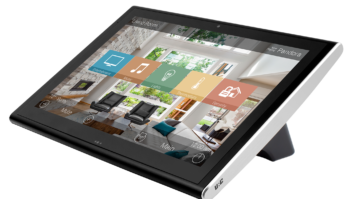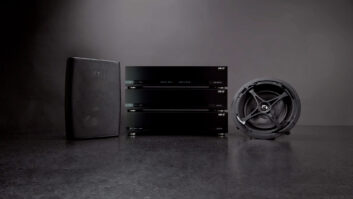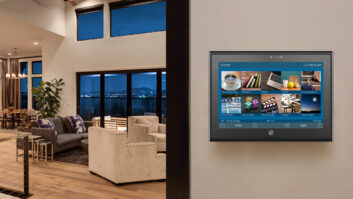It was almost exactly a year ago that I walked into URC’s new training room in Harrison, NY, and learned just about everything there was to know about the company’s long-awaited Total Control home automation line. After that press-only training session, I quoted URC director of business development Mitchell Klein, as saying, “Because this is an entirely new line, we’re starting from the ground up on our training program. We want to make sure everyone gets the information they need.”


Chang K. Park, founder and CEO of URC, welcomes the 16 dealer attendees to the fourth installment of Total Control training in Harrison, NY.
As I sat through the fourth installment of URC’s totally revamped dealer training last week in Harrison, it was clear that Klein’s prediction had come true. I attended the fourth of what will be a series of three-day trainings on the east and west coasts for dealers interested in selling Total Control. Dubbed “Mission: Control” URC’s dealer training sessions offer an overview of Total Control products and applications, an inside look at new Total Control products, and specific instructions for configuring a system, concluding with hands-on programming and installation.
Then vs. Now
The differences between now and a year ago are that the company’s Total Control line is fully shipping to dealers (in fact some of the dealers in my class already had installed systems in the field) and that there are new products that have been added to the line. The new additions include URC’s first home theater processor, the DMS-AV, the DMS-1200 8-zone multi-zone amplifier, and the MRX-4IR, which converts Wi-Fi (b/g) to IR for hard-to-reach components (a TV over a fireplace) where you can’t get an Ethernet cable.
In my opinion, the DMS-AV was most impressive of these introductions. It was designed, in part, by an engineer who worked for many years at B&K, with the goal of seamlessly tying the home theater to the rest of housewide audio distribution system. The DMS-AV’s 7.1 processor (125 watts x 7) upconverts to 1080p and shares all inputs from the network. All analog units are accessible in the receiver; the processor even has a Phono input that enables the output of a turntable to be streamed around the house. The DMS-AV features built-in calibration software and a sleek industrial design with no buttons on the front–only a volume knob.
One missing piece of the line is the company’s iOS app for iPhones and iPads. For a company renowned for its own remote control hardware, the app is definitely an accessory more than a requirement, but you’ve got to have it in today’s Apple-centric world and it’s promised to dealers within the next few weeks.
Russ Hoffman, URC’s manager of content development and the head trainer for Mission: Control
The Network is the Key
Last year, Russ Hoffman, URC’s manager of content development and the head trainer for Mission: Control emphasized the idea of Total Control’s Native to the Network” architecture for multi-room audio distribution. A year later, that jargon has been replaced with more familiar “IP” and “networking” terminology, but URC is still emphasizes to dealers in training how important a home’s network is to distributing full-fidelity non-compressed and synchronized non-buffered audio around a client’s home.
Although Total Control is network-based with a focus on TCP-IP, some devices use Wi-Fi or URC’s 2.4 GHz RF to enable wireless access where hard wiring is not practical. Hoffman and Klein pointed out that Total Control system is DHCP-capable, but emphasized the need to assign static IP addresses with MAC filtering will guarantee the quickest response time and reduce the likelihood of network crashes when streaming CD-quality audio over the network.
Programming in Hours, Not Days
One the big selling points of Total Control is the speed with which a system can be programmed. A full design, which could consist of up to 32 zones of music with full home theater integration, takes a matter of mere hours to program, rather than days or weeks. URC remains committed to an architecture that is flexible enough for customization yet not to the point of encouraging feature-creep that overwhelms the user experience or the programming process itself.
A big point covered last year was Total Control’s ability to empower the end-user to make their own scheduling changes to timed events designed into the system as macros. That feature is just a prominent today. Total Control offers three categories of timer-based events: alarm timers, which are equipped with “snooze” button, sleep timers (essentially a delay macro), and event timers, which can be used to turn a sprinkler system on and off or operate the home’s HVAC system, for instance. A programmer would build each of these macros into the system by, but it would be up to the end-user to set their schedule and make changes as they wished.



URC’s new Total Control home theater processor, the DMS-AV in a stack, and the TRC-1280 remote on display
Another somewhat novel URC offering is its Software Developer’s Kit (SDK), which pays URC direct dealers a fee for creating their own two-way modules for non-URC devices to work with Total Control. URC will create modules for the most obvious products, but has determined after its experience with creating modules for its CCP line that were underutilized, that it was best to put this process in the hands of integrators.
Just as notable is URC’s new Master Dealer program, which rewards Total Control direct dealers not only for their sales numbers (based on the size of the company) but also on their continuing education on the product.
“Master Dealer is about your commitment to Total Control—having product on display, keeping up with your training… and then sales volume,” explained director of marketing Cat Toomey during the final day of training.
Attendee Demographics
The Mission: Control session that I attended was filled with a group of 16 intelligent and thoughtful dealers that were a blend of veterans and newcomers from the DC, Chicago, Boston, and New York areas. I spoke with several of them, with one veteran integrator, Ronnie Zielinski from Creative Systems in Natick, MA, saying that he was not looking to replace either one of the big-name control brands in his line, but that Total Control offered a more complete answer to Sonos, with better margin.
“I sold Sonos because that’s what clients wanted,” Zielinski told me one morning at breakfast, “but the fact that it’s proprietary and only does music is a killer. With Total Control I can control audio and video through one interface. Before, the client had to pick up their Sonos remote then go to a URC remote in the media room. Clients want to have one easy-to-use interface. And as much as we talk about it, they don’t want to have to go into app to app to app, either.”

The hands-on portion of Total Control training
Most of the integrators in attendance have been loyal URC dealers for years, having developing a deep level of trust for the company’s reliable remote control products. And, as was emphasized in opening remarks by URC’s always-humble CEO Chang K. Park, as well as senior VP and general manager Doug Cole, when a company supplies “over 100 million remotes through all of our channels (custom, retail, cable, OEM) over the last 10 years,” as URC has, failure is not an option.
And the company is committed to bringing the same standard of quality to home automation. “We’re investing heavily in the home automation space,” Cole said. “Our goal is to be a leader in the space, and we’re on the threshold.”







